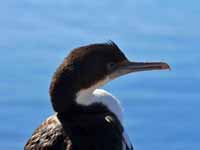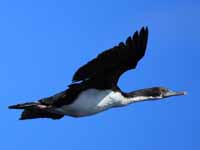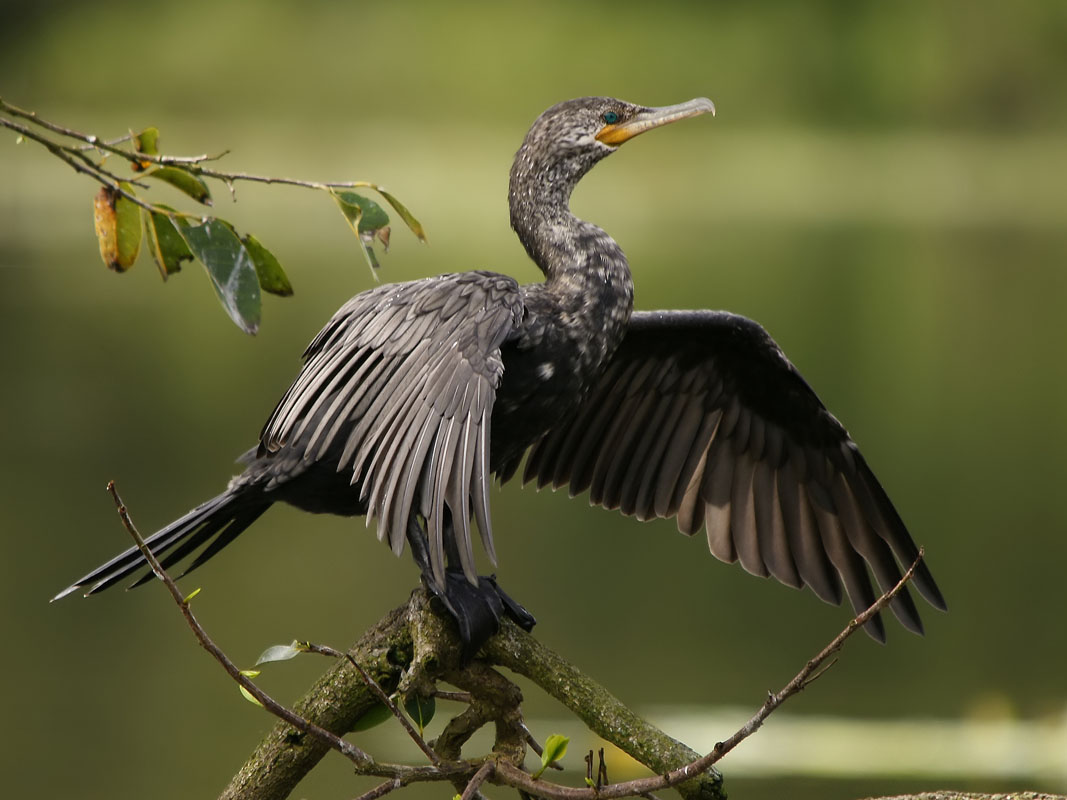THE WORLD BIRDS - An Online Bird Book
SULIFORMES
Cormorants
Order Suliformes Family Phalacrocoracidae
SULIFORMES
The Suliformes order is made up of 4 families: anhingas (Anhingidae), cormorants (Phalacrocoracidae), bobbies and gannets (Sulidae), and frigatebirds (Fregatidae). These are diving birds, they plunge for prey, often from a considerable height. Because of this, their nostrils are protected from water inhalation. For example, gannets nostrils are located inside their mouth. Suliforme chicks are altricial; they are born naked and helpless. Most of the order have large wingspans. An exception is the flightless cormorant of the Galapagos.
Suliformes all have webbing that connects four toes. Ths is also true for pelicans and tropicbirds. They contrast with ducks ang geese that have just 3 webbed toes. Quite recently, all of the suliformes were considered to belong to the same order as the pelicans: Pelicaniformes. Suliformes share another property with the pelicans, they all have bare gular sacs. Of course, this sac has evolved to the extreme with pelicans which use it for fishing.
Suliformes all have webbing that connects four toes. Ths is also true for pelicans and tropicbirds. They contrast with ducks ang geese that have just 3 webbed toes. Quite recently, all of the suliformes were considered to belong to the same order as the pelicans: Pelicaniformes. Suliformes share another property with the pelicans, they all have bare gular sacs. Of course, this sac has evolved to the extreme with pelicans which use it for fishing.
Cormorants
Order Suliformes Family Phalacrocoracidae
The names cormorant and shag are used almost interchangeably. If fact, which you prefer might be more a function of where you live than the species you are referring to. That said, if a species has a crest, that raises the odds of it being term a shag,
There is not agreement about how many genera there should be for the cormorants. This presentation has used only two: Microcarbo for the smaller cormorants and Phalacrocorax for everything else. The cormorants with blue eye-rings, commonly referred to as blue-eyed shags, are often split into genus Leucocarbo.
Every species of cormorant swims underwater to catch fish for eating. They have thus evolved certain characteristics to aid their aquatic hunting. Webbed feet are an obvious must for efficient swimming; all ducks have them too. But not all ducks swim underwater, many are so buoyant that it is physically impossible for them get their entire body under the surface of the water.
Cormorants have evolved to be dense birds so that when they are underwater they have about the same density as their surroundings. They have to spend little energy fighting buoyancy. In order that their feathers do not retain lots of air when they submerge, they not produce much water repellant oil as do ducks. The saying is “like water off a duck”, not “like water off a cormorant”. As a result, a characteristic posture of cormorants is standing facing the sun with their wing outspread to dry.
Cormorants pay a price for their underwater efficient design. They have to work harder than most birds at flying. Take off is particularly challenging. To help get into flight mode, cormorants typically use their webbed feet to run along the surface as their wings beat energetically. And after liftoff is successful, their initial flight is close to the water so that the downward beat of the wings will get some lifting pressure reflected from the water surface.
While they are graceful underwater, on land they are clumsy walkers because their feet have been optimized for swimming, not walking. As a result, they walk as little as possible. When is the last time you saw a cormorant walk?
Cormorants catch their prey by pursing it - swimming rapidly after it. Some species try to limit the escape route of the potential meal by hunting close to the sea bottom. And of course there is not just fish in the sea: worms, eels, mollusks, crustaceans, octopus, said and more are on their menu.
When is a cormorant not a cormorant? When it is an anhinga! Anhingas look and act like cormorants, but they are distinctive enough to merit their own family Anhingidae. There is just one genus anhinga and four species. Contrasted with cormorants, anhingas have wider tails and thinner more pointed bills.
Genus Microcarbo
This genus contains the smallest of the cormorants. Some consider these species to be part of Phalacrocorax.
Cormorant,_Crowned Microcarbo coronatus
Description: The crowned cormorant has a small crest at the front of its crown. It has all black plumage, but red eyes and red facial skin around the lores. Juveniles have dark brown upperparts, paler brown underparts, and no crest. The red eyes of the crowned cormaorant are unique among small African cormorants. It was previously considered conspecific with reed cormorant, which has a longer tail.
Range: southwest Africa, from Angola to southwest South Africa.
Habitat: Mainly marine, going perhaps only 100 m inshore to roost or breed. Keeps within 10 km of shore. The population appears to be stable, but there may be less than 10,000 birds.
Diet: Fish, small crustaceans.
Conservation status: Near threatened.
Image by: 1, 2) Dick Daniels - Cape Town waterfront, South Africa 3, 4) Jerry Oldenettel - Namibia 5) Ryanvanhuyssteen - South AfricaRange: southwest Africa, from Angola to southwest South Africa.
Habitat: Mainly marine, going perhaps only 100 m inshore to roost or breed. Keeps within 10 km of shore. The population appears to be stable, but there may be less than 10,000 birds.
Diet: Fish, small crustaceans.
Conservation status: Near threatened.
1, 2) Juvenile. Identification based on Birds of Souhern Africa by Kenneth Newman. The white belly contrasts with a juvenile Cape Cormorant. The beak has no hook at the end, contrasted with juvenile Great Cormorant. However, Crowned Cormorants are not found commonly on shore so this ID is not definite.
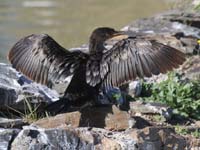
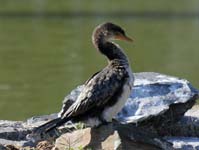
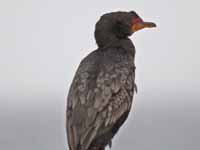
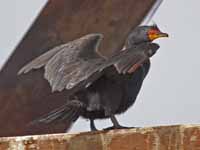
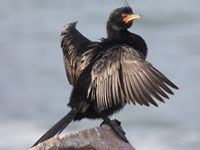
Cormorant,_Little Microcarbo niger
Description: The little cormorant is slightly smaller than the Indian cormorant. It has a shorter bill than the Indian cormorant, while the latter has a relatively peaked head, The little cormorant has black plumage, black feet, and black eyes. When not in the breeding season, the plumage has a brown tinge to the black and there is often a white patch on the throat. During breeding season there may be some white facial spots.
Range: Indian Subcontinent and east to Java.
Habitat: Lives near freshwater: small ponds, large lakes, streams; sometimes coastal estuaries.
Diet: Fish; maybe sea urchins.
Conservation status: Least concern.
Image by: 1) Ravi Vaidyanathan 2) JJ Harrison - Thailand 3) J M Garg - India 4) MV_Bhaktha - IndiaRange: Indian Subcontinent and east to Java.
Habitat: Lives near freshwater: small ponds, large lakes, streams; sometimes coastal estuaries.
Diet: Fish; maybe sea urchins.
Conservation status: Least concern.
1, 2) Nonbreeding 3, 4) Breeding
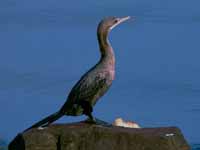

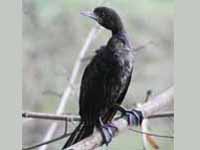
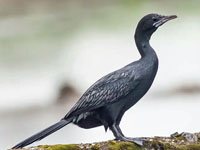
Cormorant,_Little Pied Microcarbo melanoleucos
Description: The little pied cormorant, also known as the little shag, is a black and white bird: black above and white below. The contrasting black and white plumage is sufficient to identify this species. It has dark lores, a short yellow bill, and black feet. In New Zealand some little pied cormorants have mostly black underparts with a white throat.
Range: Australia, New Guinea, New Zealand.
Habitat: Lives near bodies of water such as swamps, lakes, lagoons, estuaries, the coast..
Diet: Mainly fish, crustaceans; also eels, insect larvae.
Conservation status: Least concern
Image by: 1, 2) Dick Daniels - New Zealand 3) Michael Jefferies - Australia 4) Nik_Borrow - AustraliaRange: Australia, New Guinea, New Zealand.
Habitat: Lives near bodies of water such as swamps, lakes, lagoons, estuaries, the coast..
Diet: Mainly fish, crustaceans; also eels, insect larvae.
Conservation status: Least concern
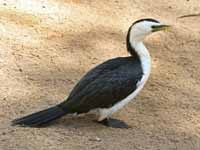
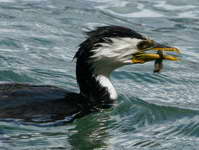

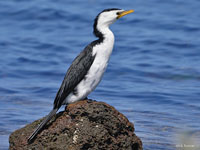
Cormorant,_Pygmy Microcarbo pygmaeus
Description: The nonbreeding pygmy cormorant has brown plumage which is darker on the back. It has a pale greyish bill. During breeding season it has black plumage, a black bill, and a short erectile crest. The pygmy cormorant is very like the little cormorant, but the crest is often more noticeable in the pygmy cormorant.
Range: southern Europe; southwest Asia. About 3/4 population lives in Europe.
Habitat: Prefers waterbodies with vegetation; especially rice fields. During winter, estuaries make the list.
Diet: Fish.
Conservation status: Least concern.
Image by: 1) Sergey Yeliseev - Bulgaria 2) Georgi_Peshev - Greece 3) Franceso Veronesi - Hungary 4) Martin Mecnarowski - HungaryRange: southern Europe; southwest Asia. About 3/4 population lives in Europe.
Habitat: Prefers waterbodies with vegetation; especially rice fields. During winter, estuaries make the list.
Diet: Fish.
Conservation status: Least concern.

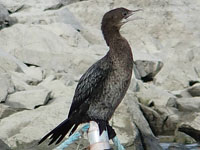
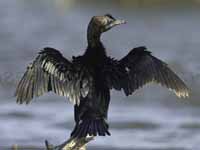
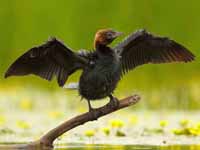
Cormorant,_Reed also Long-tailed Cormorant Microcarbo Africanus
Description: The Reed cormorant has a relatively long tail, and for that reason it is also known as the long-tailed cormorant. It has black legs and a yellow bill with red or yellow skin at the bill’s base and also the lores. During breeding season it has glossy black plumage and a short crest. In the rest of the year the long-tailed cormorant has blackish-brown upperparts and whitish underparts. Southern races may retain their head crest after the breeding season.
Range: sub-Saharan Africa.
Habitat: Prefers freshwater ponds, rivers, marshes, protected coasts. Usually hunts in shallow water; can dive deep.
Diet: Slow moving fish; also frogs, aquatic invertebrates, small birds.
Conservation status: Least concern.
Image by:
1) Paul Bernard 2, 3) Dick - Fish Eagle Lodge, Knysna Lagoon in Kenya 4) Steve GarvieRange: sub-Saharan Africa.
Habitat: Prefers freshwater ponds, rivers, marshes, protected coasts. Usually hunts in shallow water; can dive deep.
Diet: Slow moving fish; also frogs, aquatic invertebrates, small birds.
Conservation status: Least concern.
1) Juvenile
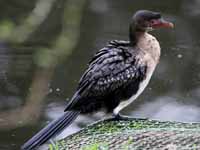


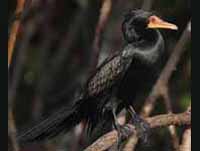
Genus Phalacrocorax
Some species in this genus are termed blue-eyed shags, which refers to eye-rings, not eye color. They are the Antarctic shag, imperial shag, Kerguelen shag, Macquarie shag, South Georgia shag, and white-bellied shag. Some consider them all as subspecies of the imperial shag. The blue-eyed shags and others with similar plumage are often put in a separate genus Leucocarbo. Note: the terms shag and cormorant are used indiscriminately with these species.
Cormorant,_Bank also Wahlberg's Cormorant Phalacrocorax neglectus
Description: The bank cormorant, also known as Wahlberg's cormorant, has mainly black plumage with dark brown wings. It is glossy with a bronze sheen. The bank cormorant has a blackish bill, black legs, and yellow eyes.
Range: African west coast (Namibia and South Africa).
Habitat: Found coastal and up to 10 km offshore. Prefers kelp beds that house lobster. Mainly breeds on islands and rocky shores.
Diet: Fish, crustaceans, squid, octopus, mollusks.
Conservation status: This cormorant is endangered with a population that is declining due to fishing reducing their prey and more kelp gulls that eat their eggs and chicks. There are about 1000 birds left.
Image by: 1) Nifanion 2) Colin Haycock 3) Frans_Vandevalle 4) Paul BernardRange: African west coast (Namibia and South Africa).
Habitat: Found coastal and up to 10 km offshore. Prefers kelp beds that house lobster. Mainly breeds on islands and rocky shores.
Diet: Fish, crustaceans, squid, octopus, mollusks.
Conservation status: This cormorant is endangered with a population that is declining due to fishing reducing their prey and more kelp gulls that eat their eggs and chicks. There are about 1000 birds left.
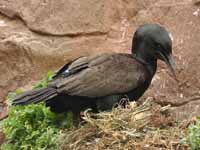
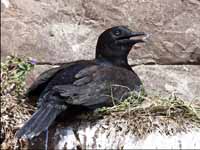
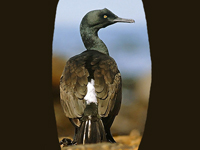
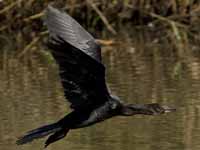
Cormorant,_Black-faced Phalacrocorax fuscescens
Description: The black-faced cormorant has black upperparts, bill, and facial skin. It has a black cap which extends below its eyes leading to its name. The underparts are white. The black-faced cormerant can be differentiated from the similar little pied cormorants and pied cormorants by the black that extends below their eyes. Juveniles have brownish-black upperparts with brownish-white face and neck.
Range: southern Australia.
Habitat: Mainly coastal and marine; also river estuaries.
Diet: Mainly fish; also squid and octopus.
Conservation status: Least concern. Images captions with links to large photos: (Image: Flying Freddy) (Image: JJ Harrison) (Image: Ron Knight)
Image by: 1, 2)
JJ Harrison - Tasmania Australia 3) Flying Freddy - Hobart, Tasmania 4) Ron_Knight - TasmaniaRange: southern Australia.
Habitat: Mainly coastal and marine; also river estuaries.
Diet: Mainly fish; also squid and octopus.
Conservation status: Least concern. Images captions with links to large photos: (Image: Flying Freddy) (Image: JJ Harrison) (Image: Ron Knight)


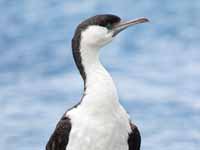

Cormorant,_Brandt's Phalacrocorax penicillatus
Description: The Brandt's Cormorant has mainly black plumage, but it does have a white cheek patch. During breeding season there are white plumes on the neck and back; there is also at this time a blue throat patch. The Brandt’s cormorant can be differentiated from the similar pelagic cormorant by its white check and also its blue throat patch while breeding.
Range: Pacific coast of North America.
Habitat: Coastal environments suck as estuaries and lagoons. Dives to 60 meters (200 ft).
Diet: Herring, rockfish and other readily available fish. Also shrimp, crabs.
Conservation status: Least concern.
Image by: 1) Alan Veron - California 2) Alan D. Wilson - California 3) Teddy Llovet - California 4) Franco Folini - California 5) Becky_Matsubara - CaliforniaqRange: Pacific coast of North America.
Habitat: Coastal environments suck as estuaries and lagoons. Dives to 60 meters (200 ft).
Diet: Herring, rockfish and other readily available fish. Also shrimp, crabs.
Conservation status: Least concern.
1) Juvenile 2, 3) Nonbreeding 4, 5) Breeding
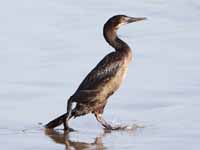
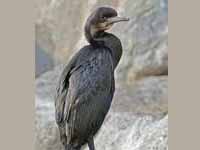
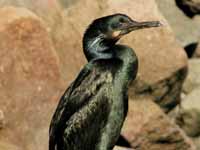
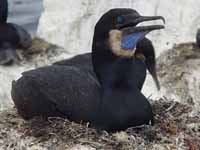
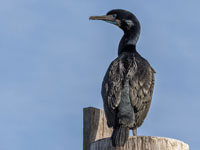
Cormorant,_Cape also Cape Shag Phalacrocorax capensis
Description: The cape cormorant has glossy black plumage with a purplish tinge during the breeding season. It does not have a crest, but it does have orange-yellow facial skin. Unusual for cormorants, a flock of cape cormorants will fly above the water searching for fish. When found, they will then swim after the fish in pursuit.
Range: coastal Angola, Namibia, South Africa.
Habitat: Often found at open sea, within 10 km of shore.
Diet: Fish, crustaceans, mussels.
Conservation status: The cape cormorant is listed as endangered as it periodically suffers great losses due to disease or prey moving due to environmental changes. There still may be over 100,000 individuals, but their future is in doubt.
Image by: 1, 2, 3) Dick Daniels - Cape Town 4) Amanda - South AfricaRange: coastal Angola, Namibia, South Africa.
Habitat: Often found at open sea, within 10 km of shore.
Diet: Fish, crustaceans, mussels.
Conservation status: The cape cormorant is listed as endangered as it periodically suffers great losses due to disease or prey moving due to environmental changes. There still may be over 100,000 individuals, but their future is in doubt.
1) Adult and juvenile
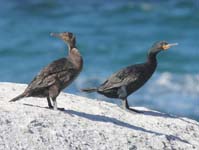
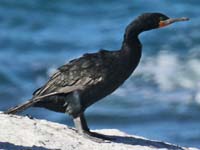
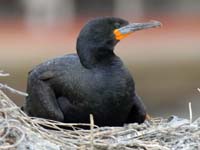
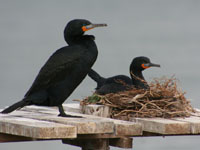
Cormorant,_Double-crested Phalacrocorax auritus
Description: The double-crested cormorant is the most numerous and widespread of the 6 North American cormorant species. It has black plumage and a bare patch of orange-yellow facial skin. There is a small black-and-white crest during the breeding season. Juveniles have lighter upperparts and whitish underparts.
The great cormorant is larger and bulkier than double-crested cormorant while the double-crested cormorant has more yellow on its throat and bill. The neotropic cormorant is smaller than double-crested cormorant and usually has a longer tail.
Range: Mainly North America, also Central America.
Habitat: Near coasts, rivers, lakes. Dives down to 8 meters (25 ft).
Diet: Mainly fish; also amphibians, crustaceans.
Conservation status: Least concern.
Image by: 2, 3) Dick Daniels - North Carolina 1) Dick - Half Moon Bay, California 4) Dick - Lake Okeechobee, Florida 5) Robert - New York 6) Mike Baird - CaliforniaThe great cormorant is larger and bulkier than double-crested cormorant while the double-crested cormorant has more yellow on its throat and bill. The neotropic cormorant is smaller than double-crested cormorant and usually has a longer tail.
Range: Mainly North America, also Central America.
Habitat: Near coasts, rivers, lakes. Dives down to 8 meters (25 ft).
Diet: Mainly fish; also amphibians, crustaceans.
Conservation status: Least concern.
1, 2) Juvenile 3, 4) nonbreeding 5) breeding eastern 6) breeding western
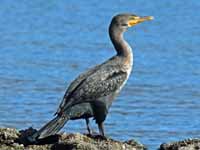
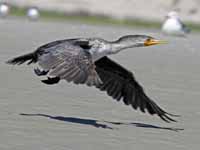
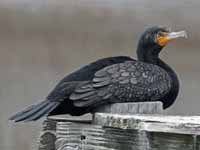

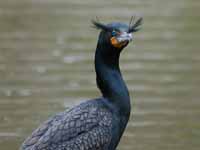
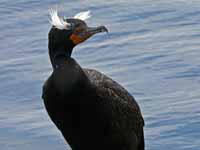
Cormorant,_Flightless Phalacrocorax harrisi
Description: The flightless cormorant is the only nonflying cormorant. The wings are about 1/3 the size of what is necessary for flight. It has blackish upperparts, brown underparts, and turquoise eyes.
Range: Galapagos Islands.
Habitat: No more than 200 meters off shore. Nests on rocky shores.
Diet: Fish, octopus, squid, eels.
Conservation status: The flightless cormorant is listed as vulnerable. It evolved as flightless as it had no predators it needed to escape. Along with humans came dogs and cats which they cannot escape by flying. The population seems to be stable at about 1000.
Image by: 1) Putneymark 2) James Preston 3) Brian_Gratwicke 4) NOAA Photo LibraryRange: Galapagos Islands.
Habitat: No more than 200 meters off shore. Nests on rocky shores.
Diet: Fish, octopus, squid, eels.
Conservation status: The flightless cormorant is listed as vulnerable. It evolved as flightless as it had no predators it needed to escape. Along with humans came dogs and cats which they cannot escape by flying. The population seems to be stable at about 1000.
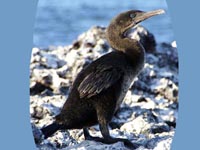
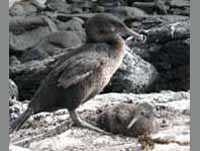
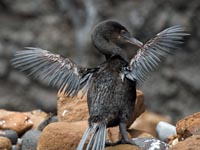
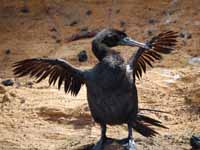
Cormorant,_Great Phalacrocorax carbo
Description: Except for the subspecies white-breasted cormorant, the great cormorant has mainly black plumage. It has a long tail, a yellow throat patch, and white near its bill. During the breeding season there is white on its head. The white-breasted cormorant (Phalacrocorax c. lucidus) has white on its neck that extends to the upper-breast.
Range: east coast North America, Europe, Asia, Africa, Australia, New Zealand.
Habitat: Found at the coast, freshwater lakes and ponds.
Diet: Mainly fish. Most fish caught near bottom, some at higher levels. Dives to 6 meters (20 ft); stays under for up to 30 seconds.
Conservation status: Least concern.
Similar species:
* European shag - “great” is larger than the European shag and has a thicker bill.
* Double-crested cormorant - “double-created” has more yellow on its throat and bill.
Image by: 1) Oystercatcher - Australia 2)
Dick Daniels - New Zealand 3) Andy Li 4) Dick - Plettenberg Bay, South Africa Range: east coast North America, Europe, Asia, Africa, Australia, New Zealand.
Habitat: Found at the coast, freshwater lakes and ponds.
Diet: Mainly fish. Most fish caught near bottom, some at higher levels. Dives to 6 meters (20 ft); stays under for up to 30 seconds.
Conservation status: Least concern.
Similar species:
* European shag - “great” is larger than the European shag and has a thicker bill.
* Double-crested cormorant - “double-created” has more yellow on its throat and bill.
1) Juvenile 2) nonbreeding 3) breeding 4) White-breasted Cormorant
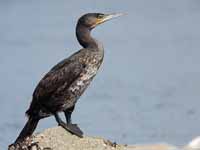
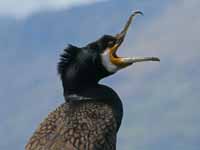
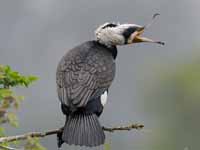

Cormorant,_Guanay Phalacrocorax bougainvillii
Description: The guanay cormorant is a major producer of guano deposits, hence its name. It has black upperparts, head, and neck. The underparts are white. There is red facial skin, a grey bill with some red at base, and red feet. The guanay cormorant has similar coloration as the rock cormorant, but the former is larger.
Range: Pacific coast South America; mainly Chile, Peru.
Habitat: Mainly located off shore islands.
Diet: Mainly Peruvian anchoveta, a small plentiful fish.
Conservation status: Near threatened.
Image by: 1) Jens Tobiska 2) Nick Athanas - Peru 3) Charlie Westerinen - Peru 4) Richard - PeruRange: Pacific coast South America; mainly Chile, Peru.
Habitat: Mainly located off shore islands.
Diet: Mainly Peruvian anchoveta, a small plentiful fish.
Conservation status: Near threatened.
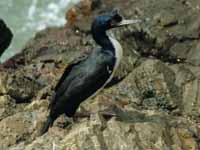

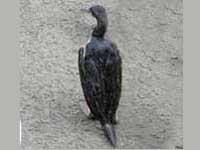
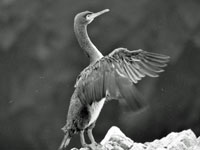
Cormorant,_Indian Phalacrocorax fuscicollis
Description: The Indian cormorant has a mainly dark appearance with bronzed wings. It has blue eyes, a small and slightly peaked head, and a long narrow bill that ends in a hook. During the breeding season the plumage becomes mainly glossy black versus brownish-black at other time. The similar little cormorant is lightly smaller than the Indian cormorant and has a considerably smaller bill.
Range: southern Asia.
Habitat: River inlets, mangroves, estuaries; not the open coast.
Diet: Mainly fish.
Conservation status: Least concern.
Image by: 1, 3) J
M Garg - India 2) Lip Kee Yap - India 4) Vijay_IsmavelRange: southern Asia.
Habitat: River inlets, mangroves, estuaries; not the open coast.
Diet: Mainly fish.
Conservation status: Least concern.
1, 2) Nonbreeding 3) Breeding 4) with Asian Open Bill Stork
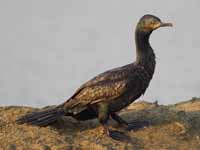
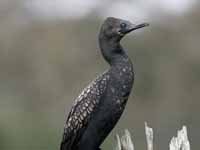
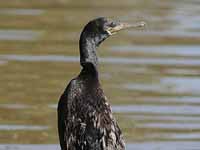
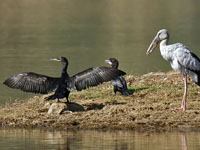
Cormorant,_Japanese Phalacrocorax capillatus
Description: The Japanese cormorant, also known as Temminck’s cormorant, has been domesticated for centuries by Japanese fisherman as helpers. It has a black body, white cheeks and throat, and a white patch on the flanks. The bill is partially yellow. The Japanese cormorant and great cormorant are very similar: “Japanese” has greenish upper-wing coverts while “great” has brownish.
Range: coastal east China and Russia; Korea, Japan, Taiwan.
Habitat: Located along the coast (not far inland) or the adjacent sea.
Diet: Mainly fish which they catch by pursuit swimming.
Conservation status: Least concern.
Image by: 1) Siebold 2) Aomonkuma 3) Michael Jefferies - Japan 4) Rachid_H - TokyoRange: coastal east China and Russia; Korea, Japan, Taiwan.
Habitat: Located along the coast (not far inland) or the adjacent sea.
Diet: Mainly fish which they catch by pursuit swimming.
Conservation status: Least concern.
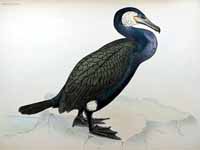
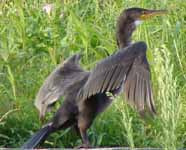

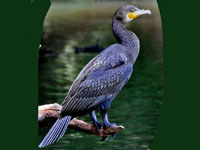
Cormorant,_Little Black Phalacrocorax sulcirostris
Description: The little black cormorant has black plumage and black legs. Its long and slender bill is grey. The eyes are blue-green. Juveniles have brown and black plumage plus brown eyes. The little black cormorant is more brownish when it is not the breeding season.
Range: Australia, northern New Zealand.
Habitat: Mainly freshwater, occasionally coastal.
Diet: Mainly fish.
Conservation status: Least concern.
Image by: 1, 2) Dick Daniels - Australia 3) Geoff_Whalan - NT - Australia 4) birdsaspoetryRange: Australia, northern New Zealand.
Habitat: Mainly freshwater, occasionally coastal.
Diet: Mainly fish.
Conservation status: Least concern.
1) Juvenile
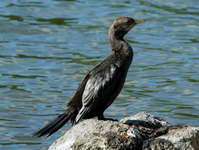
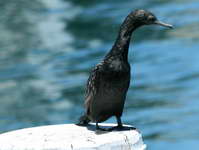
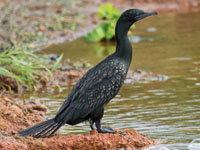

Cormorant,_Neotropic Phalacrocorax brasilianus
Description: The neotropic cormorant mainly has black plumage and a yellow-brown throat porch. In the breeding season there are white tufts on the sides of the head and the throat patch has white edges. Juveniles have brownish plumage. The neotropic cormorant is small and slender compared to the larger, double-crested cormorant.
Range: Extreme south US to tip of South America. A very large range for a cormorant.
Habitat: Coastal and inland waters. Adapts to diverse habitats; which explains its large range.
Diet: Fish, frogs, insects.
Conservation status: Least concern.
Image by: 1) Greg M - Texas 2) Daniele Columbo - Brazil 3) Dick - Panama 4) J N Stuart - New Mexico 5) Dario Sanches - BrazilRange: Extreme south US to tip of South America. A very large range for a cormorant.
Habitat: Coastal and inland waters. Adapts to diverse habitats; which explains its large range.
Diet: Fish, frogs, insects.
Conservation status: Least concern.
1) Juvenile 2) nonbreeding adult 3, 4) breeding adult
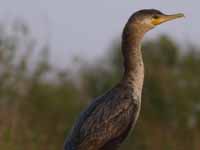
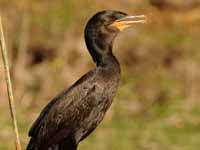

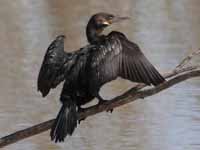
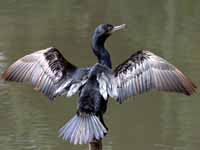
Cormorant,_Pelagic Phalacrocorax pelagicus
Description: The pelagic cormorant has iridescent black plumage. It has black feet, a long thin black bill, and green eyes. During breeding season it has white flanks and one or two short black crests on the head. The patch of dark naked skin below the eyes turns red in the breeding season.
Range: Pacific Coast of North America and Asia.
Habitat: Sheltered bays and inlets, but also far out to sea. They nest on rocky coasts.
Diet: Mainly fish, also crustaceans.
Similar to:
* Brandt’s cormorant. Brandt's cormorant has a white cheek. Also, in breeding season Brandt's cormorant has a blue throat.
* Double-breasted cormorant. Pelagic cormorant is smaller and more slender. Pelagic cormorant has red facial skin when breeding.
* Red-faced cormorant. Breeding red-faced cormorants have extensive red on their face while the red of breeding pelagic cormorants is restricted to below their eyes. Nonbreeding red-faced cormorants still have some red on their face while pelagic cormorants do not.
Conservation status: Least concern.
Image by: 1) Kevin Cole - Morro Rock on the Pacific Coast of USA 2) Dick Daniels - Kachemak Bay, AlaskaRange: Pacific Coast of North America and Asia.
Habitat: Sheltered bays and inlets, but also far out to sea. They nest on rocky coasts.
Diet: Mainly fish, also crustaceans.
Similar to:
* Brandt’s cormorant. Brandt's cormorant has a white cheek. Also, in breeding season Brandt's cormorant has a blue throat.
* Double-breasted cormorant. Pelagic cormorant is smaller and more slender. Pelagic cormorant has red facial skin when breeding.
* Red-faced cormorant. Breeding red-faced cormorants have extensive red on their face while the red of breeding pelagic cormorants is restricted to below their eyes. Nonbreeding red-faced cormorants still have some red on their face while pelagic cormorants do not.
Conservation status: Least concern.
3) Tom Talbert - California 4) Linda Tanner 5) Mike Baird - California 6) Blake_Matheson
2) With common guillemot
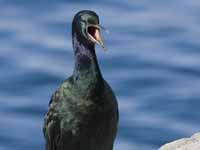
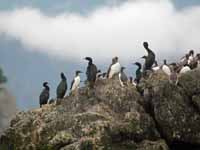
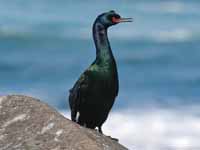
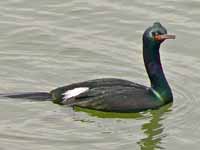

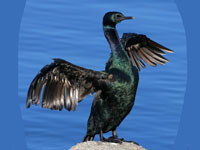
Cormorant,_Pied also Australian Pied Cormorant Phalacrocorax varius
Description: The pied cormorant, also known as the Australian pied cormorant, has black upperparts and also black legs and feet. The black on the head stays above the eyes, below is white. The pied cormorant has white underparts and orange lores.
Range: Australia, New Zealand.
Habitat: Mainly marine, also ponds and lakes. Forages usually less than 10 meters deep (30 ft).
Diet: Mainly fish; also crustaceans, octopus, squid.
Similar to:
* Black-faced Cormorant. Black-faced cormorant black cap covers the eyes; pied cormorant has white above the eyes.
* Little Pied Cormorant. Pied cormorant is much bigger than little pied cormorant and has a proportionally longer bill.
* Rough-face Shag. Pied cormorant has black feet; rough-faced shag has pink feet.
Conservation status: Least concern.
Image by: 1, 3, 4) Dick Daniels - New Zealand 2) Laurie_BoyleRange: Australia, New Zealand.
Habitat: Mainly marine, also ponds and lakes. Forages usually less than 10 meters deep (30 ft).
Diet: Mainly fish; also crustaceans, octopus, squid.
Similar to:
* Black-faced Cormorant. Black-faced cormorant black cap covers the eyes; pied cormorant has white above the eyes.
* Little Pied Cormorant. Pied cormorant is much bigger than little pied cormorant and has a proportionally longer bill.
* Rough-face Shag. Pied cormorant has black feet; rough-faced shag has pink feet.
Conservation status: Least concern.
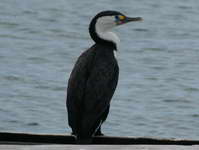
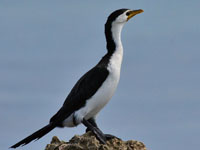
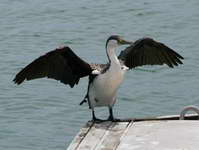

Cormorant,_Red-faced Phalacrocorax urile
Description: The red-face cormorant has glossy black plumage with greenish-blue iridescence. While in the breeding season it has orange or red facial skin and a double crest. The orange / red facial skin is slightly visible when not in the breeding season.
Range: Asia, Alaskan coast.
Habitat: Almost exclusively marine. Ventures a few meters onshore to roost and nest. Similar to: Pelagic cormorant. The ranges of these two species are very similar and they often share the same breeding grounds. Breeding red-faced cormorants have extensive red on their face while the red of breeding pelagic cormorants is restricted to below their eyes. Nonbreeding red-faced cormorants still have some red on their face while Pelagic Cormorants do not.
Conservation status: Least concern.
Image by: 1) Budd Christman - Alaska 2) USFWS 3) Art Sowls, USFWS - Alaska 4) Bill Bouton - AlaskaRange: Asia, Alaskan coast.
Habitat: Almost exclusively marine. Ventures a few meters onshore to roost and nest. Similar to: Pelagic cormorant. The ranges of these two species are very similar and they often share the same breeding grounds. Breeding red-faced cormorants have extensive red on their face while the red of breeding pelagic cormorants is restricted to below their eyes. Nonbreeding red-faced cormorants still have some red on their face while Pelagic Cormorants do not.
Conservation status: Least concern.
4) with a Parakeet Auklet
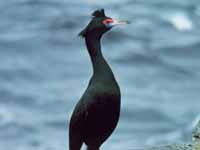
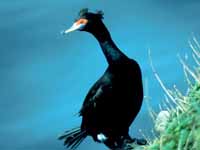
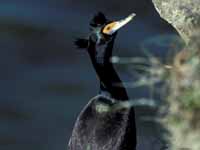
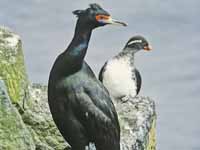
Cormorant,_Red-legged Phalacrocorax gaimardi
Description: As expected, the red-legged cormorant does have bright red legs and feet. It has mainly grey plumage with white spots on the wings and a white patch on the neck. The tail is black, the eyes are green, and the bill yellow.
Range: South America, mainly on the west coast.
Habitat: Near the shore and relatively close to its nest. It avoids freshwater.
Diet: Fish, especially anchovies, and eels.
Conservation status: The red-legged cormorant is considered near threaded because, even though its range is wide, it population density is small; and probably getting smaller.
Image by: 1) Nanosmile - Argentina 2, 3) Nick Athanas - Peru 4) Brendan_Ryan - ChileRange: South America, mainly on the west coast.
Habitat: Near the shore and relatively close to its nest. It avoids freshwater.
Diet: Fish, especially anchovies, and eels.
Conservation status: The red-legged cormorant is considered near threaded because, even though its range is wide, it population density is small; and probably getting smaller.
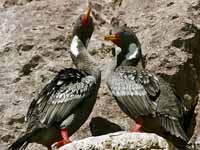
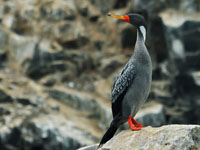
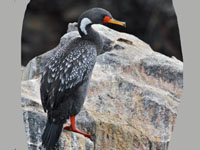

Cormorant,_Socotra Phalacrocorax nigrogularis
Description: The Socotra Cormorant has blackish plumage and blackish legs. During the breeding season it has greyish-green tinged upperparts and glossy purple-tinged fore-crown. It is found in the Persian Gulf and the southeast coast of the Arabian Peninsula.
Range: Persian Gulf of Asia.
Habitat: Very much a marine bird which nests on isolated islands.
Diet: Mainly fish.
Conservation status: The Socotra cormorant is listed as vulnerable, even though there are thought to be over a quarter million of birds. There is concern because of coastal development and pollution near its breeding sites.
Image by: 1) Tupala 2) Nepenthes - Abu DhabiRange: Persian Gulf of Asia.
Habitat: Very much a marine bird which nests on isolated islands.
Diet: Mainly fish.
Conservation status: The Socotra cormorant is listed as vulnerable, even though there are thought to be over a quarter million of birds. There is concern because of coastal development and pollution near its breeding sites.

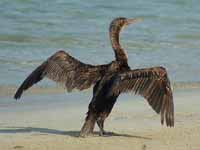
Shag,_Antarctic Phalacrocorax bransfieldensis
Description: The Antarctic shag (cormorant) has blue eye-rings and sometimes be referred to as a “blue-eyed shag”. It has black upperparts including the head. Its black wings have white wing-bars. There is a yellow fleshy patch above the bill, a white patch on the back, and pink feet. During the breeding season there is a crest on head.
Range: Antarctic Peninsular and nearby islands
Habitat: Marine. Inhabits coasts and island.
Diet: Fish, crustaceans, octopus, squid.
Conservation status: Least concern.
Range: Antarctic Peninsular and nearby islands
Habitat: Marine. Inhabits coasts and island.
Diet: Fish, crustaceans, octopus, squid.
Conservation status: Least concern.
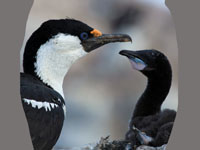
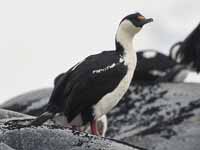
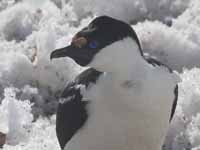
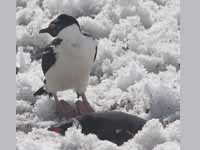
Shag,_Auckland Islands Phalacrocorax colensoi
Description: The Auckland Islands shag has black upperparts and sometimes a white wing-bar. It has white underparts and a white throat. The Auckland Island shag has blue eye-rings and is one of the “blue-eyed shags”.
Range: Auckland Islands which are south of New Zealand.
Habitat: At sea or along the coast. Nests in rock areas and also flat ground.
Diet: Crustaceans and fish.
Conservation status: Considered vulnerable because there are less than 2000 birds and they do not have geographical diversity.
Image by: 1) Justin Friend 2) Su Yin Khoo 3) M MurphyRange: Auckland Islands which are south of New Zealand.
Habitat: At sea or along the coast. Nests in rock areas and also flat ground.
Diet: Crustaceans and fish.
Conservation status: Considered vulnerable because there are less than 2000 birds and they do not have geographical diversity.
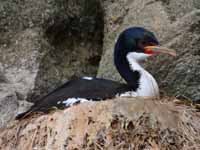
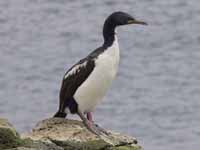
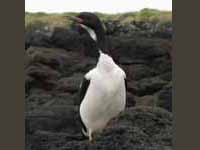
Shag,_Bounty_Islands Phalacrocorax ranfurlyi
Description: The Bounty Islands shag, also known as the Bounty shag, has black upperparts and nape with a blue metallic sheen. The underparts are white and there is a white patch on the wings that appears as a wing-bar when folded. The feet are pink. The Bounty Islands shag has blue eye-rings and is one of the “blue-eyed shags”.
Range: Bounty Islands - which are southeast of New Zealand.
Habitat: Open seas and rocky shores.
Diet: Fish, crustaceans, octopus, squid.
Conservation status: The Bounty Islands shag is considered vulnerable because there are less than 1000 birds, plus it has have a small breeding range. The population does seem stable.
Range: Bounty Islands - which are southeast of New Zealand.
Habitat: Open seas and rocky shores.
Diet: Fish, crustaceans, octopus, squid.
Conservation status: The Bounty Islands shag is considered vulnerable because there are less than 1000 birds, plus it has have a small breeding range. The population does seem stable.
Shag,_Campbell Phalacrocorax campbelli
Description: The Campbell Islands shag, which is also called the Campbell shag, has blue eye-rings and is sometimes referred to as a “blue-eyed shag”. It has black upperparts, neck, and head. The underparts are white and some of these shags have white wing-bars.
Range: Cambell Island (south of New Zealand).
Habitat: Stays within 10 km of Campbell Island; also its rocky shores.
Conservation status: The Campbell Island shag is listed as vulnerable because it breeds only on one island. However, the population seems to be doing quite well has rats and cats on Campbell Island seem have been eliminated.
Range: Cambell Island (south of New Zealand).
Habitat: Stays within 10 km of Campbell Island; also its rocky shores.
Conservation status: The Campbell Island shag is listed as vulnerable because it breeds only on one island. However, the population seems to be doing quite well has rats and cats on Campbell Island seem have been eliminated.
Shag,_Chatham Phalacrocorax onslowi
Description: The Chatham Islands shag has black upperparts including the head which is black. It has white underparts, a dark grey bill, and dull pink legs. The Chatham Islands shag has blue eye-rings and is one of the “blue-eyed shags”.
Range: Chatham Islands of New Zealand.
Habitat: Breeds along the coast, hunts within a few km of shore in sheltered areas.
Conservation status: The Chatham Islands shag is critically endangered because of humans disturbing their nesting areas and introduced predators such as feral cats.
Image by: 1)
Biodiversity_Heritage_LibraryRange: Chatham Islands of New Zealand.
Habitat: Breeds along the coast, hunts within a few km of shore in sheltered areas.
Conservation status: The Chatham Islands shag is critically endangered because of humans disturbing their nesting areas and introduced predators such as feral cats.
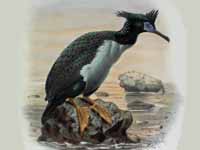
Shag,_European also Common Shag Phalacrocorax aristotelis
Description: The European shag, also known as the common shag, is a medium sized cormorant which has black plumage and a yellow gape. It has a long thin tail. In the breeding season there is a greenish sheen to the plumage. The great cormorant is larger than the European shag and has a thicker bill.
Range: Iceland, Europe (coastal Scandinavia to Mediterranean), southeast corner of Asia, northwest Africa.
Habitat: Coastal, rare inland.
Diet: Fish, eels.
Conservation status: Least concern.
Image by: 1) Julius Ruckert - Croatia 2, 5) Andreas Trepte 3) Martin Mecnarowski - Norway 4) MPF -
Northumberland, UK Range: Iceland, Europe (coastal Scandinavia to Mediterranean), southeast corner of Asia, northwest Africa.
Habitat: Coastal, rare inland.
Diet: Fish, eels.
Conservation status: Least concern.
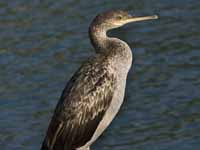
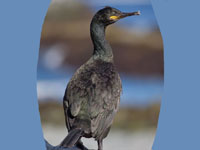
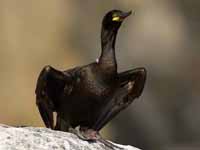

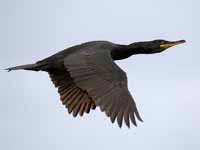
Shag, Foveaux Phalacrocorax stewarti
The Foveaux shag (P. stewarti) and the Otago shag (P. chalconotus) were both previous considered to be conspecific as the Stewart Island shag.
Description: The Foveaux shag has two morphs. The bronze morph has dark bronze plumage. The pied morph has bronze upperparts with a white patch on the folded wing and white underparts. It has blue eye-rings and is one of the “blue-eyed shags”. The Foveaux shag can be identified by the bright orange caruncles they have during breeding season which are lacking in the Otago shag.
Range: New Zealand (Stewart Island and Foveaux Strait).
Habitat: Forages mainly along the coast, but also 10 or more km offshore. Roosts and nests on rocky shores.
Diet: Mainly fish; also crustaceans, squid, octopus.
Conservation status: The Stewart Island shag is now considered vulnerable. They were plentiful before New Zealand became populated with people. Now there may be about 2500, and the population may be still declining.
Image by: 1) Jim Scarff Description: The Foveaux shag has two morphs. The bronze morph has dark bronze plumage. The pied morph has bronze upperparts with a white patch on the folded wing and white underparts. It has blue eye-rings and is one of the “blue-eyed shags”. The Foveaux shag can be identified by the bright orange caruncles they have during breeding season which are lacking in the Otago shag.
Range: New Zealand (Stewart Island and Foveaux Strait).
Habitat: Forages mainly along the coast, but also 10 or more km offshore. Roosts and nests on rocky shores.
Diet: Mainly fish; also crustaceans, squid, octopus.
Conservation status: The Stewart Island shag is now considered vulnerable. They were plentiful before New Zealand became populated with people. Now there may be about 2500, and the population may be still declining.
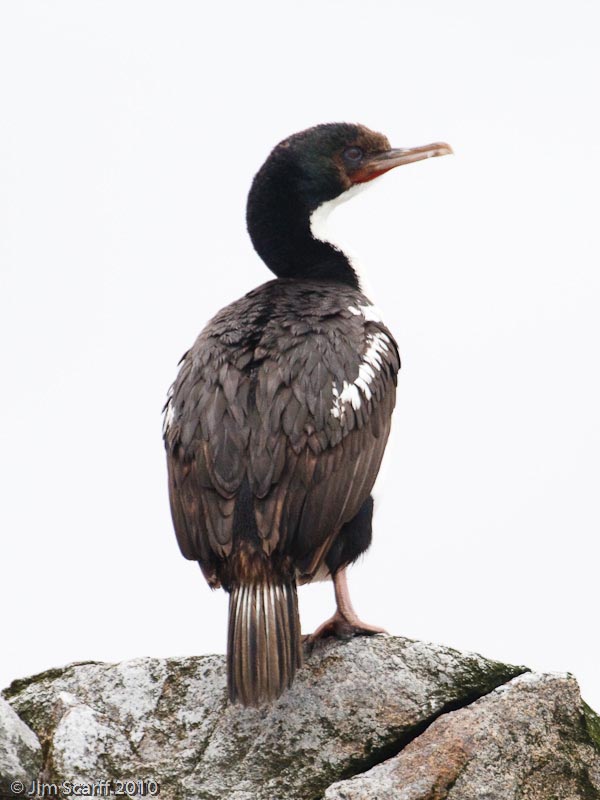
Shag,_Heard_Island Phalacrocorax nivalis
Description: The Heard Island shag has mainly black upperparts with wide white wing-bars and white underparts. The cheeks and ear-coverts are also white, the bill is dark, and the feet are pink. During breeding season there is a crest on the head and orange fleshy patches (caruncles) above the bill’s base. The Heard Island shag has blue eye-rings and is one of the “blue-eyed shags”. It usually has more white on the upperparts than other shags in its range.
Range: Heard and McDonald Islands (Antarctic islands southwest of Perth, Australia).
Habitat: Prefers shallow coastal waters around their islands for hunting. They roost and nest mainly on cliffs, but also on beaches.
Conservation status: The Heard Island shag is vulnerable because of its small population which is around 1000. Any increase in commercial fishing could threaten their existence.
Range: Heard and McDonald Islands (Antarctic islands southwest of Perth, Australia).
Habitat: Prefers shallow coastal waters around their islands for hunting. They roost and nest mainly on cliffs, but also on beaches.
Conservation status: The Heard Island shag is vulnerable because of its small population which is around 1000. Any increase in commercial fishing could threaten their existence.
Shag,_Imperial Phalacrocorax atriceps
Description: The imperial cormorant (shag) has blue eye-rings and may be referred to as a “blue-eyed shag”. It has black upperparts including the nape. The underparts including the fore-neck are white. The imperial cormorant has an orange-yellow nasal knob, pinkish legs, and pinkish feet. In breeding season there is a black erectile crest. The rock shag is similar, but has an entirely black neck. However, some shag species with blue-eye rings are difficult to distinguish from the imperial cormorant. Identification is often based on location and may not be accurate.
Range: southern Argentina and Chile.
Habitat: Primarily rocky coastal regions; also large inland lakes.
Diet: Fish, crustaceans, octopus, worms.
Conservation status: Least concern.
Image by: 1) Richard Crook
2) Calyponte Beagle Channel, southern Argentina 3, 4) Charlie Westerinen - Ushuaia, Argentina in the Beagle ChannelRange: southern Argentina and Chile.
Habitat: Primarily rocky coastal regions; also large inland lakes.
Diet: Fish, crustaceans, octopus, worms.
Conservation status: Least concern.
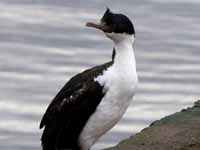
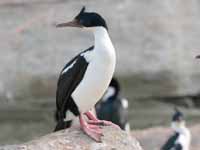
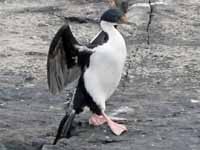

Shag,_Kerguelen Phalacrocorax verrucosus
Description: The Kerguelen shag has black upperparts, tail, and thighs. It has blackish facial skin and a dark blue forehead. Some have white patches on the wings and back; The underparts and throat are white. There are orange fleshy bumps (caruncles) above base of bill. In breeding season they have brighter plumage and there is a small erectile crest. The Kerguelen shag has dull blue eye-rings and is the smallest blue-eyed shag. Juveniles are mainly dark brown, they lack caruncles, and have brown feet;
Range: Kerguelen Islands in southern Indian Ocean.
Habitat: The Kerguelen shag forages at sea, but usually within 6 km (4 mi) of shore.
Diet: Fish, crustaceans, worms. Hunt alone in summer; large group otherwise.
Similar to: Heard Island shags range rarely overlaps. “Heard” has white cheeks, “Kerguelen” does not.
Conservation status: Least concern.
Image by: 1, 2, 3) GazelleRange: Kerguelen Islands in southern Indian Ocean.
Habitat: The Kerguelen shag forages at sea, but usually within 6 km (4 mi) of shore.
Diet: Fish, crustaceans, worms. Hunt alone in summer; large group otherwise.
Similar to: Heard Island shags range rarely overlaps. “Heard” has white cheeks, “Kerguelen” does not.
Conservation status: Least concern.
1) Chick 2) Juvenile 3) Adult
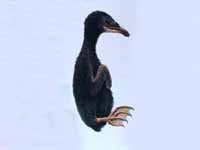
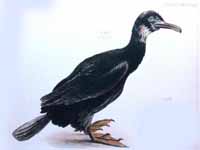

Shag,_Macquarie Phalacrocorax purpurascens Found:
Description: The Macquarie shag, named after its favorite island, has mainly black upperparts including the crown and nape. It has white wing-bars. The underparts, fore-neck and face are white. During breeding season there are orange fleshy growths (caruncle) above the bill’s base The Macquarie shag has blue eye-rings and is one of the “blue-eyed shags”.
Range: Macquarie Island and closely islets (between New Zealand and Antarctica).
Habitat: Breeds and roost on islands, other than that it is a marine bird.
Diet: Fish, crustaceans, octopus.
Conservation status: The Macquarie shag is vulnerable because there are less than a 1000 birds and they live in a localized region. Severe weather or food shortage can be problematic and introduced rats add to their problems.
Image by: 1) Hullwarren Range: Macquarie Island and closely islets (between New Zealand and Antarctica).
Habitat: Breeds and roost on islands, other than that it is a marine bird.
Diet: Fish, crustaceans, octopus.
Conservation status: The Macquarie shag is vulnerable because there are less than a 1000 birds and they live in a localized region. Severe weather or food shortage can be problematic and introduced rats add to their problems.
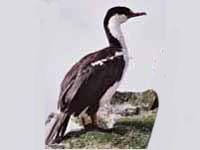
Shag, Otago also Stewart Island Shag Phalacrocorax chalconotus
The Foveaux shag (P. stewarti) and the Otago shag (P. chalconotus) were both previous considered to be conspecific as the Stewart Island shag.
Description: The Otago shag has two morphs. The bronze morph has dark bronze plumage. The pied morph has bronze upperparts with a white patch on the folded wing and white underparts. It has blue eye-rings and is one of the “blue-eyed shags”. The Foveaux shag can be identified by the bright orange caruncles they have during breeding season which are lacking in the Otago shag.
Range: New Zealand (islets off Otago Peninsular on eastern coast of the South Island).
Habitat: Forages mainly along the coast, but also 10 or more km offshore. Roosts and nests on rocky shores.
Diet: Mainly fish; also crustaceans, squid, octopus.
Conservation status: The Stewart Island shag is now considered vulnerable. They were plentiful before New Zealand became populated with people. Now there may be about 5000, and the population may be still declining.
Image by: 1) Wayne Hodgkinson - Dunedin, New Zealand 2) Gary Clark 3) 57Andrew Description: The Otago shag has two morphs. The bronze morph has dark bronze plumage. The pied morph has bronze upperparts with a white patch on the folded wing and white underparts. It has blue eye-rings and is one of the “blue-eyed shags”. The Foveaux shag can be identified by the bright orange caruncles they have during breeding season which are lacking in the Otago shag.
Range: New Zealand (islets off Otago Peninsular on eastern coast of the South Island).
Habitat: Forages mainly along the coast, but also 10 or more km offshore. Roosts and nests on rocky shores.
Diet: Mainly fish; also crustaceans, squid, octopus.
Conservation status: The Stewart Island shag is now considered vulnerable. They were plentiful before New Zealand became populated with people. Now there may be about 5000, and the population may be still declining.
1) Juvenile - bronze morph 3) Pied Morph


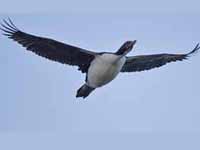
Shag, Pitt Island Phalacrocorax featherstoni
Description: During the breeding season, the Pitt Island shag has black with bluish-gloss upperparts and neck, green facial skin, and two black crests on the head, one forward and the other aft. At other seasons the upperparts tend towards dull brown, facial skin dull yellow, and the crests become less prominent and may disappear. The underparts are white and the feet yellow.
Range: Chatham islands of New Zealand.
Habitat: The sea and coasts for foraging and rocky shores for roosting and breeding.
Diet: Mainly fish; also crustaceans.
Conservation status: The Pitt Island shag is endangered because of its small number, less than 1500. Population seems to still be declining, perhaps due to changing environment affecting its prey.
Range: Chatham islands of New Zealand.
Habitat: The sea and coasts for foraging and rocky shores for roosting and breeding.
Diet: Mainly fish; also crustaceans.
Conservation status: The Pitt Island shag is endangered because of its small number, less than 1500. Population seems to still be declining, perhaps due to changing environment affecting its prey.
Shag,_Rock also Magellan Cormorant Phalacrocorax Magellanicus
Description: The Magellanic Cormorant, also known as the rock shag, has black upperparts, head, and neck. It has white underparts; red facial skin, and pinkish legs. During breeding season there is a small blackish crest and a white ear patch.
Range: South America (Patagonia, Argentina).
Habitat: It forages close to shore and does not dive much deeper than 10 meters. It nests on steep rocky cliffs.
Diet: Marine worms, fish, octopus, squid.
Conservation status: Least concern.
Similar to:
* Imperial shag has white on fore-neck; rock shag has entirely black neck.
* Guanay cormornt is larger than the rock shag.
Image by: 1) Arthur Chapman - Argentina 2) Nick Athanas - Argentina 3) Andrew Cheal - Falkland Islands 4) Ealdgyth Range: South America (Patagonia, Argentina).
Habitat: It forages close to shore and does not dive much deeper than 10 meters. It nests on steep rocky cliffs.
Diet: Marine worms, fish, octopus, squid.
Conservation status: Least concern.
Similar to:
* Imperial shag has white on fore-neck; rock shag has entirely black neck.
* Guanay cormornt is larger than the rock shag.
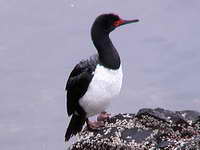
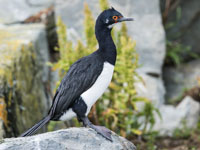
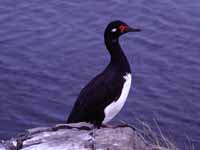
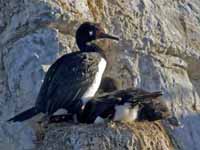
Shag,_Rough-faced also King Shag Phalacrocorax carunculatus
Description: The New Zealand king shag, also known as the rough-faced shag or king shag, has yellow-orange caruncles (wart-like swelling) near the bill. Its scientific name carunculatus refers to that feature. It has black upperparts and a black tuft on the head. The underparts are white and the feet are pink. The grey gular pouch is reddish in the breeding season. With its blue eye-ring it is one of the “blue-eyed shags”.
Range: New Zealand.
Habitat: They hunt in coastal waters and nest on rocky islands.
Diet: Fish and crustaceans.
Conservation status: The king shag is classified as vulnerable due to egg and feather collection. It is now protected and the population has stabilized.
Image by: 1) Jinjian Liang - Seaworld 2) Sabine's_SunbirdRange: New Zealand.
Habitat: They hunt in coastal waters and nest on rocky islands.
Diet: Fish and crustaceans.
Conservation status: The king shag is classified as vulnerable due to egg and feather collection. It is now protected and the population has stabilized.


Shag,_South Georgia
Description: The South Georgia shag has black upperparts including the nape. It has a white wing-bar. The underparts are white, including the underside of its neck. During breeding season the South Georgia shag has an erectile crest and orange warty flesh (caruncle) above the bill’s base. With its blue eye-ring it is one of the “blue-eyed shags”.
Range: Islands between South America and Antarctica. Specifically South Georgia, South Sandwich Islands, and South Orkney Islands.
Habitat: Marine and inshore.
Conservation status: Not globally threatened.
Image by: 1) Brian Gratwicke - South Georgia 2) Liam Quinn - South GeorgiaRange: Islands between South America and Antarctica. Specifically South Georgia, South Sandwich Islands, and South Orkney Islands.
Habitat: Marine and inshore.
Conservation status: Not globally threatened.
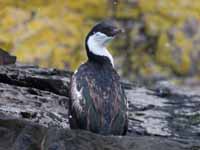
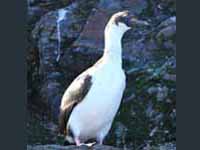
Shag,_Spotted Phalacrocorax punctatus
Description: The Spotted Shag has brown upperparts with small dark spots. The underparts are mainly white, but the lower belly is black. The sides of the neck and the face are white. The crown and the throat are blue-green. The legs of the spotted shag vary from bright yellow to dull yellowish-brown. During the mating season the spotted shag has a black crest.
Range: New Zealand, mainly the South Island.
Habitat: Coastal and offshore up to 15 km. Does not frequent fresh water. They nest in on rock shores and cliffs.
Conservation status: Least concern.
Image by: 1) Brian Gratwicke
2) Phil_Norton 3) Sid
Mosdell 4) Seabird NZ Range: New Zealand, mainly the South Island.
Habitat: Coastal and offshore up to 15 km. Does not frequent fresh water. They nest in on rock shores and cliffs.
Conservation status: Least concern.
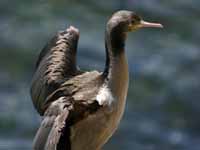
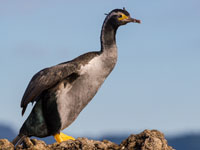
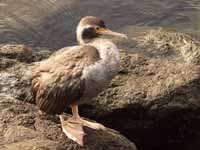
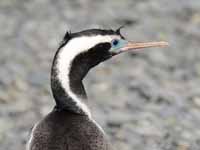
Shag,_White-bellied also King Cormorant Phalacrocorax albiventer
The White-bellied shag is also considered to be a subspecies of the the imperial shag. In that case its scientific name is Phalacrocorax atriceps albiventer. Description: The white-bellied shag has black upperparts and white underparts. Since it is only found on the Falkland Islands, the white belly of this cormorant is sufficient to identify it.
Range: Falkland Islands,
Habitat: Primarily rocky coastal regions.
Diet: Fish, crustaceans, octopus.
Conservation status: Least concern.
Image by: 1) Nestor Galina - Patagonia 2) Liam Quinn Range: Falkland Islands,
Habitat: Primarily rocky coastal regions.
Diet: Fish, crustaceans, octopus.
Conservation status: Least concern.
